Even when the heavy bike troubled me a great deal, I manage to keep my eyes open to the sights around me as we drove past Chang La.
Leaving Karu Village after a breakfast of Alu Parathas, we rode past the village of Shakti before the climb to Chang La began. If there is a village anywhere in Ladakh, there has to be monastery perched high on a crag somewhere nearby. Sure enough, there was Chemrey Monastery visible far away on the mountain slopes.
We climbed steadily keeping a deep valley and Shakthi Village to the left and the mountains to the right. Tall jagged snow-peaks of Zanskar Ranges showed up beyond the Indus Valley when I stopped at an army check-post before Chang La and looked back at the valley we had left behind.
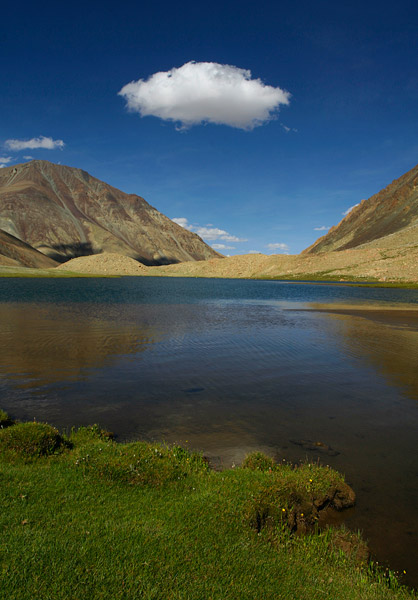
At 17,360 feet, Chang La was cold but the shining sun and absence of wind kept us in comfortable. Nevertheless, the thin mountain air and the struggles with the bike had tired me out and I was looking forward to the descent and better roads ahead. The landscape changed considerably after the pass. The valleys were wider and the slopes were gentle. There was a burst of green grass on the earth, which was a remarkable change from the arid slopes on the other side. There was more life too. Himalayan Marmots ran around playfully in the grass and wrestled with each other as we rode past them. Wild rabbits disappeared into their holes when they saw us. Where the slope was gentle, the grass was so thick and green that it completely hid the brown colour of the soil.
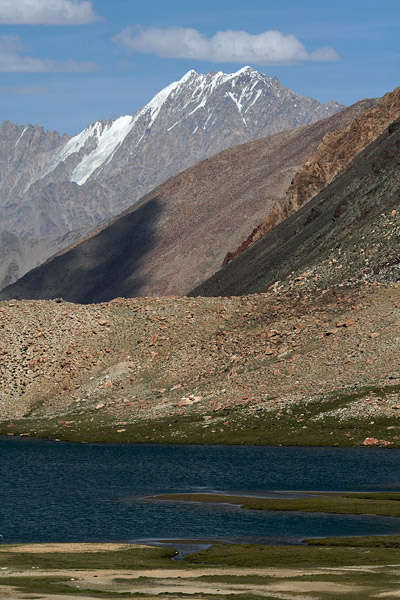
All this was great, but the greatest moment on the road came when we stumbled upon an open area with a deep blue waterbody in the middle of it. A stream that flowed from down from Chang La spread open on a grassy expanse and its blue waters reflected the mountains surrounding it. Tiny yellow and white flowers spread densely in small patches amidst the green grass. Occasional clouds that passed above the mountains reflected in the lake, creating distraction in the blue plane. The water was so clear that we could see the pebbles at the bottom as clearly as if there wasn’t any water. In the arid landscape of Ladakh, this was the first time I was seeing a natural lake so attractive that its serenity made the journey feel complete much before the destination was reached.
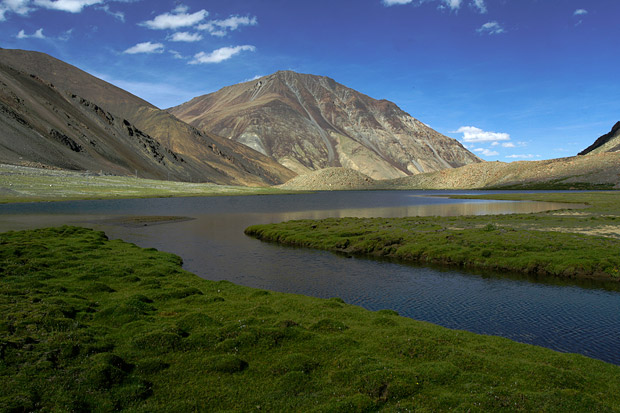
Nevertheless, the destination—Pangong Tso—still had to be reached and we were to find out soon that it involved a lot of struggle!
I rented a motor bike that weighed three times my weight and rode from Leh to Pangong Lake. Riding with a payload more than 150 kilos (me, a pillion rider and about 40 kilos of luggage) on a super heavy bike and heading to a no man’s land at an altitude of 14,000 feet was like inviting a disaster. Disaster did not come, but the hardships along the way almost forced us to abandon the journey.
The plans were grand. We were to leave Leh for Pangong Tso, spend a few days at the lake and continue further to Tso Moriri before returning to Leh. A week long trip meant carrying plenty of luggage. With us was a large 80 liter backpack, two smaller shoulder bags, a heavy tripod, two sleeping bags dangling at the back of the bike and twenty liters of fuel supplement. I would not be surprised if an onlooker thought we were shifting house. After all, Pangong is a great place to call home, especially during summer months.
Although I wasn’t very kicked up on doing these long rides on a bike, economics and logistics favoured renting one. Hiring a cab was going to be prohibitively expensive. While we did have enough time to take a bus or to look for a shared jeep, it would have been a crime to speed away through the mountains without stopping along the way to see all the beautiful sights as and when we wished. Choosing a bike seemed practical even if the ride was going to be an effort.
The beginning of the journey was smooth and easy. We made an early start and rode on the smooth highway that ran parallel to Indus until the small village of Karu. The smaller road to Pangong deviated here from the highway, but the surface nevertheless remained smooth and the ride was trouble free. Taking the bike appeared to be a good idea.
The first signs of trouble started showing up during the long climb to Chalng La, the mighty pass at 17,360 feet that we had to cross before descending towards Pangong. The Bullet Thunderbird now seemed unhappy with its load and was reluctant to respond to the accelerator at difficult ascents. It refused to go further in a few occasions when the ascent was very steep, forcing the pillion rider to walk for a few minutes till we found an easier section of the road. This however was a small problem and did not threaten us from completing the journey. But once we reached closer to Chang La, the tarmac on the road disappeared and we were left to wade streams that cut across the road, ride through mud, rocks and wet soil. It wasn’t exactly an easy ride, but was nevertheless completed by struggling to balance the heavyweight bike on rocky and slippery surfaces, sometimes supporting it by dipping my feet into the frigid waters. It must have taken us a good thirty minutes to cross the pass to be welcomed by another stretch of smooth tarmac. We were cruising again along an easy stretch, descending comfortably on a metalled road.
The big trouble however came an hour later when we least expected it. Bigger troubles were to come next day, just a few kilometers before reaching Pangong.
I have written all good things about people of Ladakh in my earlier posts in this series. Ladakhis are usually very warm and cheerful people and always carry an infectious smile (Read: Ladakh – Good Samaritans and Ladakh – Cheerful People). But in my two months of wandering in the mountain country, not every experience was good.
While in Ladakh, we had made an attempt to travel by public transport as much as possible. But there were a few exceptions, like the time we hired a bike to get to Pangong Lake to ensure that we could stop and go as we wished, or when we took a cab to get us to Tso Moriri Lake in time for a festival. The cab dropped us at Korzok Village on the bank of the lake and returned to Leh. Knowing that the date of arrival of next bus is still many days away (read about public transport in Ladakh, where I talk about buses to some places being available at an interval of every 10 days), we scouted for options to get back to Leh.
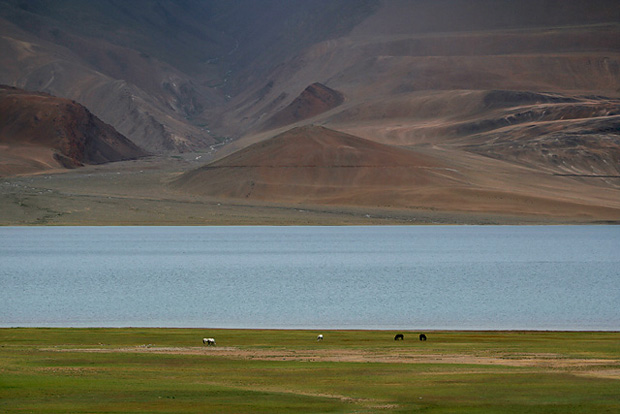
Tso Moriri Lake
Our initial plan was to look for seats to share in a returning cab or even a small truck. Since this was festival time, the inflow of tourists was higher than normal and there was a good chance to find taxis returning to Leh with some seats empty. After looking around at all the hangouts in the village, we found a group of four Israelis willing to take us back with them to Leh. These people had taken a cab from Leh to Tso Moriri and were planning to get back to town next morning, stopping for a night at Tso Kar. It suited us well. We had not planned a visit to Tso Kar earlier, but it would be good to get a glimpse of the lake, even if it is for just one evening. Although it was not necessary, we informed their driver Tashi that we would be joining the group on the next part of the journey. In a semi-inebriated condition that evening, Tashi smiled and nodded cheerfully.
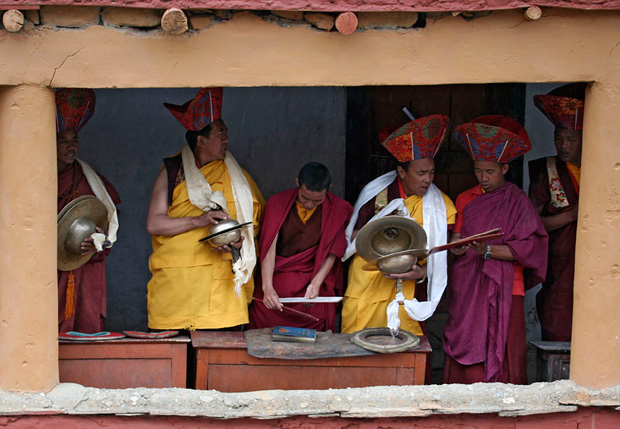
Celebrations – Korzok Gustor Festival on the banks on Tso Moriri
The next morning, we packed our bags and waited to hear from the group of Israelis when they are ready. At about 11am, one of them walked into our guest house to deliver a bad news – ‘Tashi is refusing to take you two in the cab!’ For a moment we were worried. Because we had managed to get transport yesterday, we did not bother to look further. It meant getting stranded in Korzok for at least a day, or more if there is no transport available even on the next day.
What ensued was a long argument between Tashi and us. His case was that the cab, a Tata Sumo, would not be able to pull a load of additional people in the mountain roads. It did not seem to make sense. Drivers take 10 passengers along the Manali – Leh highway in Tata Sumos every day, while here it would be just six people including us today. And if he did not want to take us, he should have refused yesterday evening when we volunteered to inform him about us joining the group. After a short exchange of words with Tashi that actually left us struggling to breathe in Tso Moriri’s this air, Tashi suddenly obliged but refused to talk to us any more.
Later in the evening when we reached Tso Kar, Tashi reminded of us struggling to accelerate in a steep slope on the way where he had to ask all of us to get out and walk a short distance. Tashi had attempted to go off road and take a steep short cut, but the cab had refused to go further. He recalled the incident in support of his argument in the morning. Now in a better mood, he also said he was very upset because we had raised our voices in Tso Moriri.
That morning, we had tried to keep a calm and worked hard to keep our voices low even when we expressed unhappiness with Tashi and argued that he can’t refuse to take us. But having walked briskly to his cab and blabbering a few sentences breathless, talking further was a struggle and we might have sounded discourteous as we spoke with difficulty, almost chokingly. I explained it to Tashi and apologized if we had sounded rude. In a region where people are so friendly that anyone getting angry is almost unimaginable, we might have sounded as if we had crossed some limits.
We finally made amends with Tashi, who opened up a bit after this conversation in Tso Kar. But it still remains a puzzle why he agreed to take us in the first place and refused later. Perhaps it was the effect of whiskey, which kept him in a generous mood when we spoke to him first!
About two weeks after we left Tso Moriri, we were to have some more uncomfortable experiences (link to a really long post on a trek in Zanskar, part of which are some unhappy experiences) while trekking in the heart of Zanskar.




